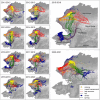Evidence for an Adaptive, Large-Scale Range Shift in a Long-Distance Terrestrial Migrant
- PMID: 39604295
- PMCID: PMC11602692
- DOI: 10.1111/gcb.17589
Evidence for an Adaptive, Large-Scale Range Shift in a Long-Distance Terrestrial Migrant
Abstract
Long-distance migrations are a striking, and strikingly successful, adaptation for highly mobile terrestrial animals in seasonal environments. However, it remains an open question whether migratory animals are more resilient or less resilient to rapidly changing environments. Furthermore, the mechanisms by which animals adapt or modify their migrations are poorly understood. We describe a dramatic shift of over 500 km in the wintering range of the Western Arctic Herd, a large caribou (Rangifer tarandus) herd in northwestern Alaska, an area that is undergoing some of the most rapid warming on Earth. Between 2012 and 2020, caribou switched from reliably wintering in maritime tundra in the southwesternmost portion of their range to more frequently wintering in mountainous areas to the east. Analysis of this range shift, in conjunction with nearly 200 documented mortality events, revealed that it was both broadly adaptive and likely driven by collective memory of poor winter conditions. Before the range shift, overwinter survival in the maritime tundra was high, routinely surpassing 95%, but falling to around 80% even as fewer animals wintered there. Meanwhile, in the increasingly used mountainous portion of the range, survival was intermediate and less variable across years compared to the extremes in the southern winter ranges. Thus, the shift only imperfectly mitigated overall increased mortality rates. The range shift has also been accompanied by changes in seasonal patterns of survival that are consistent with poorer nutritional intake in winter. Unexpectedly, the strongest single predictor of an individual's probability of migrating south was the overall survival of animals in the south in the preceding winter, suggesting that the range shift is in part driven by collective memory. Our results demonstrate the importance and use of collective decision making and memory for a highly mobile species for improving fitness outcomes in a dynamic, changing environment.
Keywords: Alaska; behavioral plasticity; caribou; climate change; collective memory; migratory range; snow; survivorship; temperature; wind.
Published 2024. This article is a U.S. Government work and is in the public domain in the USA. Global Change Biology published by John Wiley & Sons Ltd.
Conflict of interest statement
The authors declare no conflicts of interest.
Figures








Similar articles
-
Climate-driven effects of fire on winter habitat for caribou in the Alaskan-Yukon Arctic.PLoS One. 2014 Jul 3;9(7):e100588. doi: 10.1371/journal.pone.0100588. eCollection 2014. PLoS One. 2014. PMID: 24991804 Free PMC article.
-
Quantifying effects of snow depth on caribou winter range selection and movement in Arctic Alaska.Mov Ecol. 2021 Sep 22;9(1):48. doi: 10.1186/s40462-021-00276-4. Mov Ecol. 2021. PMID: 34551820 Free PMC article.
-
Variation in winter site fidelity within and among individuals influences movement behavior in a partially migratory ungulate.PLoS One. 2021 Sep 30;16(9):e0258128. doi: 10.1371/journal.pone.0258128. eCollection 2021. PLoS One. 2021. PMID: 34591944 Free PMC article.
-
Responses to projected changes in climate and UV-B at the species level.Ambio. 2004 Nov;33(7):418-35. doi: 10.1579/0044-7447-33.7.418. Ambio. 2004. PMID: 15573570 Review.
-
Biodiversity, distributions and adaptations of Arctic species in the context of environmental change.Ambio. 2004 Nov;33(7):404-17. doi: 10.1579/0044-7447-33.7.404. Ambio. 2004. PMID: 15573569 Review.
Cited by
-
Behavioral responses of migratory caribou to semi-permeable roads in Arctic Alaska.Sci Rep. 2025 Jul 9;15(1):24712. doi: 10.1038/s41598-025-10216-6. Sci Rep. 2025. PMID: 40634430 Free PMC article.
References
-
- Alerstam, T. , Hedenström A., and Åkesson S.. 2003. “Long‐Distance Migration: Evolution and Determinants.” Oikos 103, no. 2: 247–260. 10.1034/j.1600-0706.2003.12559.x. - DOI
-
- Anderson, D. D. 1998. Kuuvanmiut Subsistence: Traditional Eskimo Life in the Latter Twentieth Century. National Park Service, Department of the Interior.
-
- Anderson, J. J. , Gurarie E., Bracis C., Burke B. J., and Laidre K. L.. 2013. “Modeling Climate Change Impacts on Phenology and Population Dynamics of Migratory Marine Species.” Ecological Modelling 264: 83–97. 10.1016/j.ecolmodel.2013.03.009. - DOI
MeSH terms
Grants and funding
LinkOut - more resources
Full Text Sources

